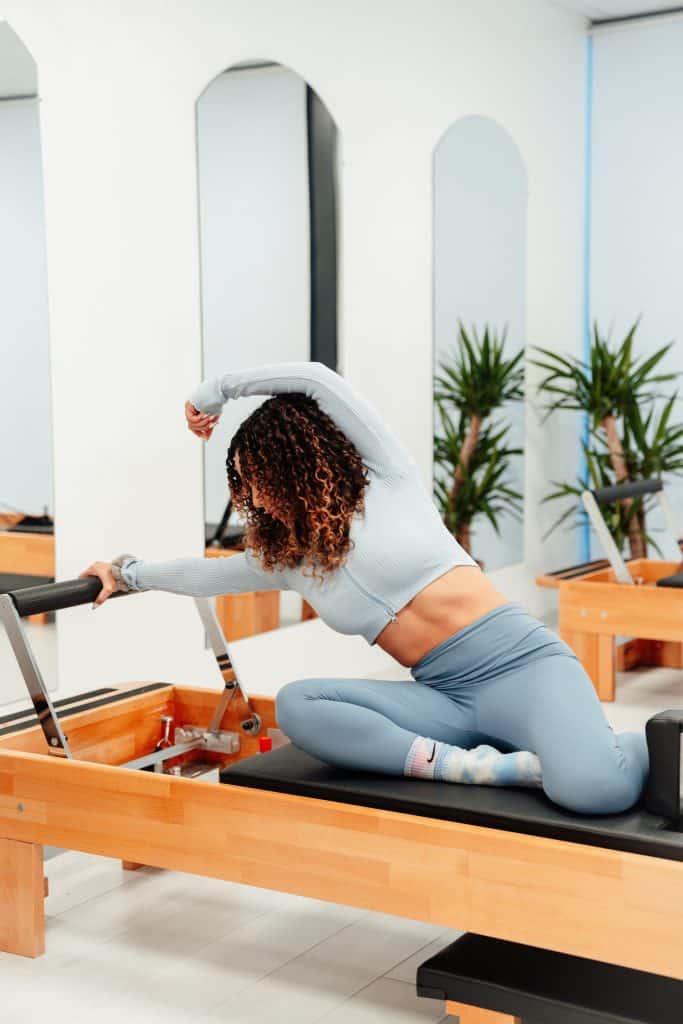What to Know Before Starting a Pilates Practice at Home
This post contains affiliate links. Click here to read my affiliate policy.
Last Updated on July 8, 2025

Starting a Pilates practice at home can feel exciting and overwhelming all at once. You might be eager to build strength, improve flexibility, or simply move more—but you’re not sure where to begin. There are countless videos, machines, and programs out there, which makes it easy to get lost before you even start. The good news is that Pilates doesn’t need to be complicated. With a few essentials, some basic knowledge, and a clear plan, you can build a sustainable, enjoyable practice right from your living room.
Pilates offers a unique combination of low-impact movement, precise muscle engagement, and mindfulness. It’s ideal for anyone looking to strengthen their body without putting unnecessary stress on joints. Before you jump in, it’s worth setting up your home practice with intention. From picking the right equipment to understanding technique and routine, the decisions you make early on can shape your long-term progress.
Set Clear Goals for Your Pilates Journey
Knowing what you want from Pilates makes everything easier. Whether you’re trying to build core strength, improve posture, support your recovery from an injury, reduce stress, or just move your body more regularly, having a clear goal keeps you focused.
Write your goal down, say it out loud, or add it to a note on your phone. If you’re training for something specific, like better back support or stronger hips, your sessions can reflect that. It’s also helpful to decide how often you want to practice each week. Keep it realistic, but consistent. Consider tracking your progress over time so you can celebrate small wins.
You might even have different goals for different days. For example, some days may be about stretching and breathwork, while others are about strength or balance. Being clear on your goals will help you choose the right exercises and maintain your motivation.
Understand the Basics of Pilates Technique
Pilates isn’t just about the movements—it’s about how you do them. Breath, alignment, control, and concentration are all core principles. Focus on connecting your breath to your movements. When you inhale and exhale with intention, you engage your core more effectively. Watch for cues about posture, shoulder positioning, and spinal alignment. Even in a short workout, these small adjustments make a big difference in how your muscles respond.
Familiarize yourself with the common Pilates terms like neutral spine, pelvic tilt, and scapular stability. The more you understand the language, the easier it will be to follow online classes or tutorials. Some instructors even offer short breakdowns of terms before diving into routines, which can be helpful if you’re just getting started.
Invest in Equipment That Suits Your Space
You don’t need a full studio to get started. A high-quality mat and some simple props like a Pilates ring, resistance bands, and a small stability ball can go a long way. Cushioned mats help protect your spine and joints, and props help you target muscles with more precision.
If you’re ready to commit to a more complete setup, consider a home-friendly reformer. The Core Collab offers compact and foldable Pilates reformers that bring the studio experience into your home. These reformers are designed with smooth gliding carriages, adjustable springs, and cushioned platforms to support your movements comfortably. Many of these models are foldable and easy to store, which is perfect if you’re working with limited room.
Start With Beginner-Friendly Routines
It’s tempting to dive into challenging flows, but giving your body time to adjust is key. Start with beginner routines that focus on fundamental exercises like pelvic tilts, bridges, leg circles, and arm presses. These movements may seem simple, but they lay the foundation for more advanced work later on.
Look for online classes or instructors who specialize in foundational Pilates. Many platforms offer progressive programs that build week after week. Following a structured plan helps you stay on track without overdoing it. You can also find classes that focus on specific goals—like posture correction, flexibility, or core stability—so you can build a practice that evolves with your needs.
Make sure your first few sessions are short and manageable. Starting with just 10 to 20 minutes can help you build consistency without feeling overwhelmed. Over time, you can increase the length and intensity of your workouts.
Learn Proper Form to Avoid Injury
Good form matters more than flashy moves. When you’re practicing at home without a trainer watching you, it’s easy to pick up habits that might lead to discomfort or strain. Pay close attention to form cues in videos and don’t rush through reps. Keep your movements slow and controlled, and check in with how your body feels during each exercise.
Mirrors can help with self-correction, or you can occasionally record yourself to review your alignment. Don’t be afraid to go back to basics if something feels off. Strength comes from precision, not speed. It’s also smart to vary your practice and try different instructors to expose yourself to new techniques and form cues.
You may want to consider taking a private session—virtually or in person—with a certified instructor, especially if you’re recovering from injury or managing a chronic condition. Even a one-time session can provide helpful feedback on your alignment and technique.
Make Room for Movement in Your Home
Create a dedicated space—even if it’s just a corner in your living room. Your body needs space to stretch out fully, especially during mat work or reformer sessions. Keep your props and equipment close so you’re not scrambling to set up each time. A tidy, designated space makes it easier to commit to your routine.
If you’re using a reformer machine, make sure there’s enough clearance around it to move safely. Most machines are designed with home users in mind, offering models that fold away or fit snugly into smaller rooms. That way, you don’t have to sacrifice comfort or safety for space. You could even keep your setup near a window or in a quiet part of the house to create a calming atmosphere for your sessions.
Consider adding a few personal touches to make the space feel inviting—a soft mat, a speaker for music, a calming scent, or a small plant can go a long way. When your space feels good, you’ll be more likely to return to it regularly.
Stick to a Consistent Schedule
Consistency always wins. It’s better to practice twice a week for months than every day for one week and then give up. Think of your Pilates sessions as appointments with yourself—non-negotiable and worth showing up for.
Try pairing your practice with another part of your routine, like rolling out your mat right after your morning coffee or setting a reminder before dinner. You can also schedule your sessions into your calendar, just like you would a meeting. Treat it as a part of your wellness routine, not a chore. Some people even find it helpful to join virtual challenges or accountability groups to stay motivated.
It helps to reflect on how your body feels after each session—stronger, calmer, more energized—and use those feelings as motivation. Over time, your Pilates practice can become a deeply rewarding part of your lifestyle, helping you feel more balanced in both body and mind.
The key is to keep showing up. Even when progress feels slow or life gets busy, remember that every session counts. The benefits of Pilates build over time, and with a consistent home practice, you’ll feel stronger, more flexible, and more in tune with your body than ever before.






